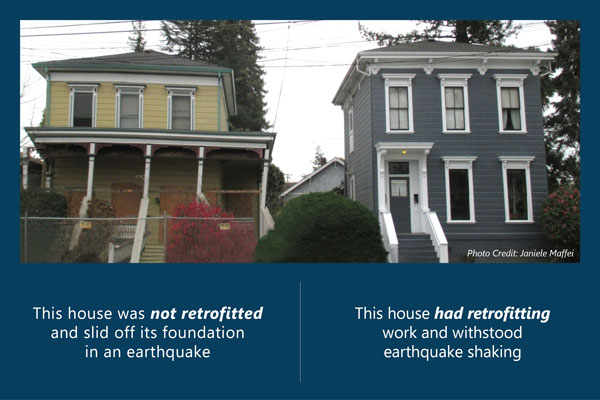Scientists say there is more than a 99 percent chance that at least one major earthquake is going to strike the Golden State in the next 30 years.*
And if your house was built before 1980, earthquake experts say these older houses are especially vulnerable to damage from earthquake shaking because they were built before modern seismic building codes were put in place.
Retrofitting older homes can be relatively simple. Bolting or bolting and bracing your house to its foundation can help prevent structural damage, such as your home from coming off its foundation.
Benefits of Getting a Retrofit
Strengthening your house with a seismic retrofit is a good way to lessen the potential for costly earthquake damage, saving you what could be tens to hundreds of thousands of dollars in repair costs. It can help provide peace of mind, knowing that you have helped your family better withstand an earthquake by strengthening where you live.
These two side-by-side houses, shown after the magnitude-6.0 2014 American Canyon (South Napa) earthquake, illustrate the benefit of a seismic retrofit: one had been strengthened, and one had not.
Increasing Your Safety
Properly retrofitted houses are made stronger against earthquake shaking and damage. This means your house is safer and you have reduced the chance of injury or even death in a devastating earthquake.
Financially Protecting Your Investment
Protecting your house is especially important when you consider that many people consider their home to be their most valuable and largest financial asset. Without a seismic retrofit, the repair costs you would face after a damaging earthquake could be very expensive.
Think of this way: it is a lot cheaper to retrofit your house before an earthquake than it is to repair it after an earthquake.
Ensuring You Have a Place to Live
The primary goals of retrofitting are to:
- Allow you and your family to shelter in place,
- Keep your house habitable, and
- For you and your family to survive when a major earthquake occurs.
If you have not seismically retrofitted your house and an earthquake causes extensive damage:
- It could take years to repair,
- You might have to move out of your house while repairs are made, and
- You may need to take out a loan to pay for those repairs. This means you could be paying repair costs, rental costs and the mortgage on your house all at the same time.
Does Earthquake Retrofitting Work?
A recent study by the Pacific Earthquake Engineering Research (PEER) Center estimates that the owners of retrofitted houses can save between $75,000 and $150,000 in repair costs resulting from a major earthquake by bracing and bolting their houses.
This research helps to demonstrate that seismic retrofits work, and earthquake retrofitting is worth it when you compare the potential cost of repairing a damaged home. Spending a smaller amount of money to help prevent damage and help give your house earthquake resistance may be more beneficial than facing a much larger repair bill after an earthquake.
How Much Does an Earthquake Retrofit Cost?
While there is not a standard cost for strengthening your home against earthquake damage, the range usually is about $3,000 to $7,000. Larger homes, those built on hillsides and those with basements and rooms over garages will typically cost more to retrofit. Many houses that require only bolting cost about $3,000.
Learn more about retrofitting costs and how to pay for a retrofit.
How Do You Retrofit a House for Earthquakes?
Strengthening a home can be straightforward and often not as intrusive as homeowners might think. Depending on the type of retrofit needed, the work usually can be done in just a few days. And, in most cases, workers are able to complete the retrofitting work without entering the home.
Learn more about the different types of home retrofits:
- Raised foundation house retrofit
- Living space over garage house retrofit
- Post & pier house retrofit
- Hillside house retrofit
- Mobilehome & manufactured house retrofit
How Long Does It Take to Retrofit a Home?
The construction itself usually takes between 1 and 3 days. In almost all cases, the work does not require entry to the inside of your home, which means now is a great time to get the ball rolling. On average, the entire project can last from 4 to 12 weeks, which includes receiving a homeowner’s permit and plans, construction and finagling of the permit by the building permit.
How Else Can You Mitigate Earthquake Damage?
There are other ways in which you can help prevent earthquake damage and protect your home and your family in the event of a major earthquake. They include:
- Strap water heaters and gas appliances to wall studs. Also, have a professional install flexible fittings to avoid gas or water leaks.
- Do not hang heavy items, such as pictures and mirrors, near beds, couches and anywhere people sleep or sit.
- Install strong latches or bolts on cabinets. Large or heavy items should be closest to the floor.
- Learn how to shut off the gas valves in your home and keep a wrench handy for that purpose.
- Place large and heavy objects and breakable items on lower shelves.
- Anchor overhead fixtures to joists.
- Anchor top-heavy, tall and freestanding furniture, such as bookcases and china cabinets, to wall studs to keep these from toppling over.
- Ask about home repair and strengthening tips for exterior home features, such as porches, decks, sliding glass doors, canopies, carports and garage doors.
Strengthen Your Home!
Strengthening your home is critical to reducing your risk of earthquake injury and damage. The frames of thousands of homes built before 1980 are not bolted to their foundations. Houses without adequate bracing and bolting can slide or topple off their foundation during an earthquake.
Many homeowners are looking for a new home project. If you want to do some worthwhile work on your home, why not start with its foundation? If your house is older and on a raised foundation, odds are it may need to be seismically retrofitted to have a better chance to withstand earthquake damage.
Is earthquake retrofitting worth it? The answer is a resounding “yes”—taking the path of most resilience by strengthening your house is worth every penny!
*According to the third Uniform California Earthquake Rupture Forecast (UCERF3) report.



